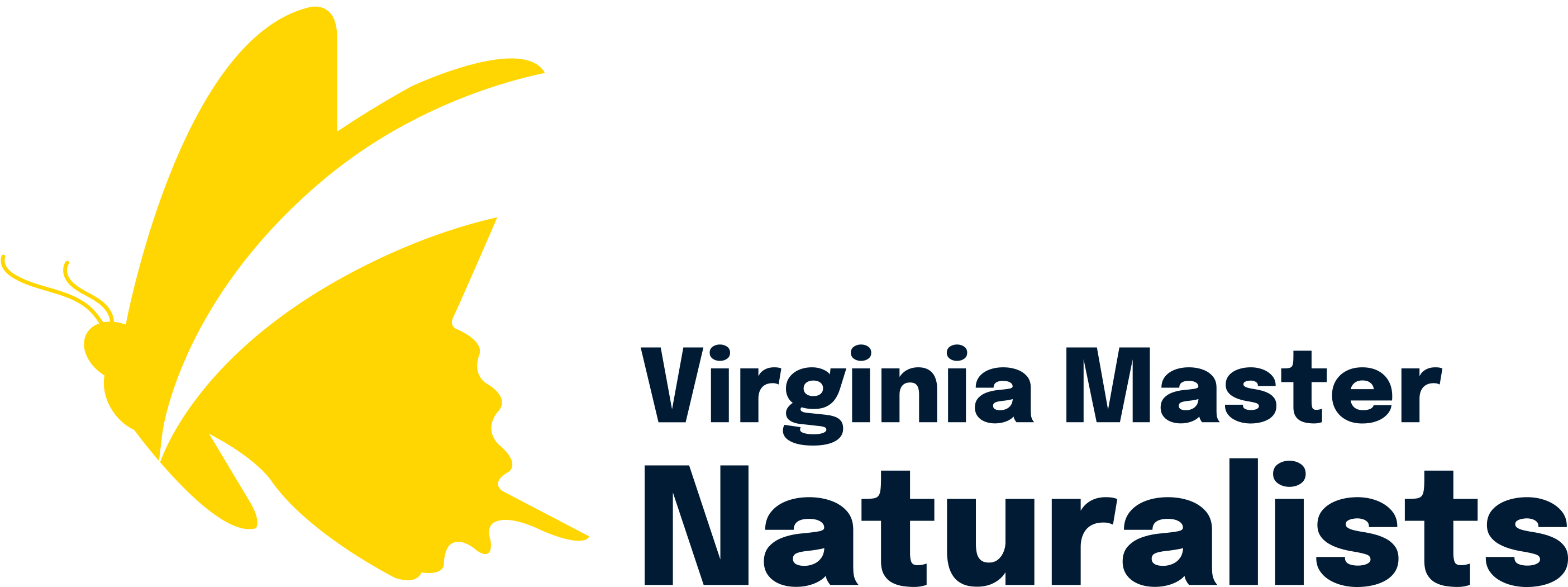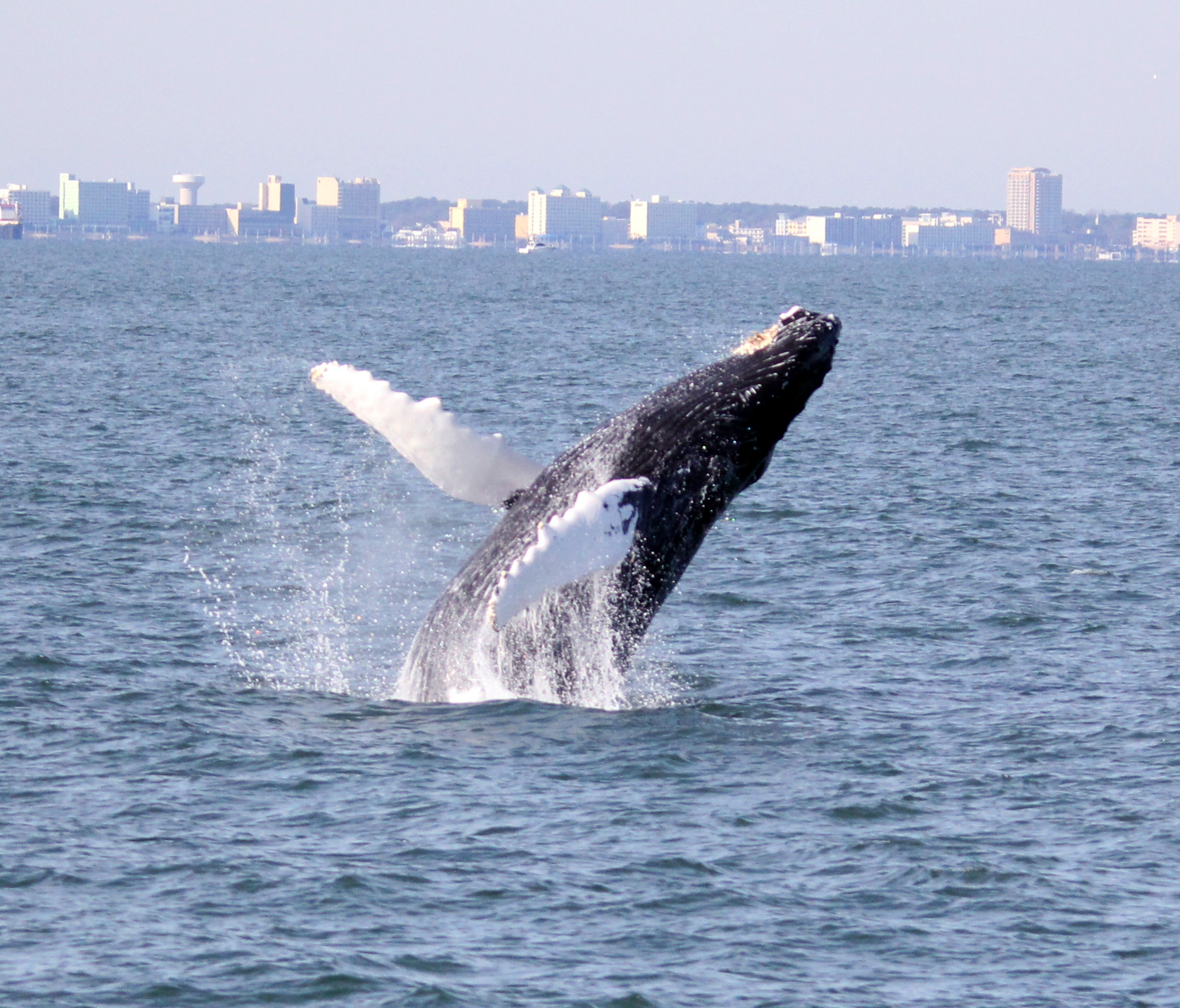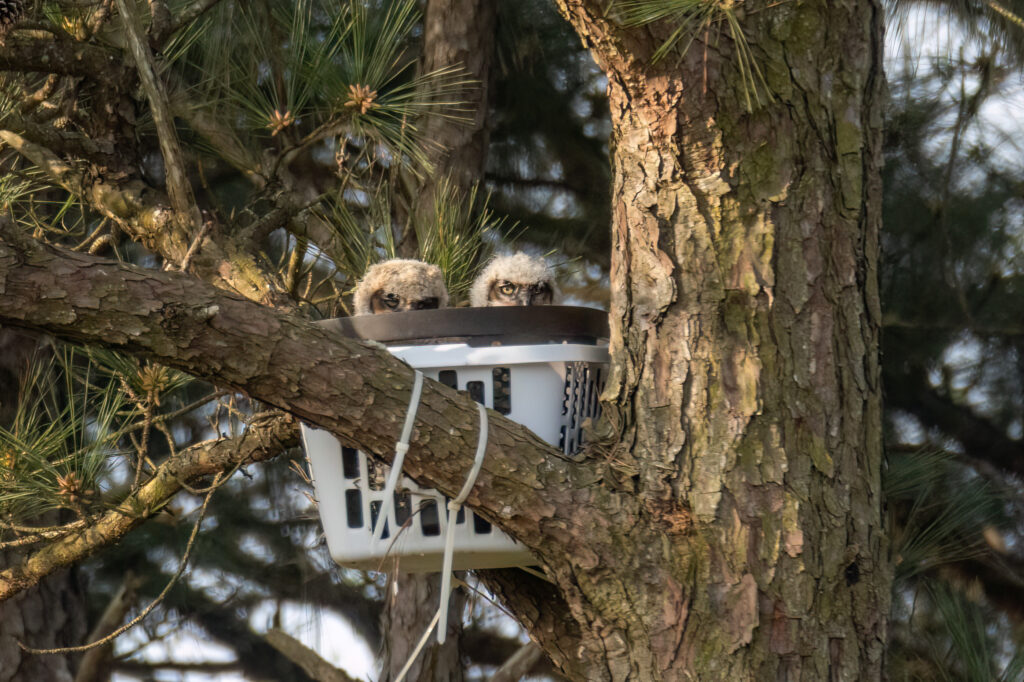Laurels – Summer 2024
Holston Rivers Master Naturalists and Hungry Mother State Park organize “Life’s Extras Birding Celebration”
–Contributed by Tanya Hall, Hungry Mother State Park and VMN-Holston Rivers Chapter
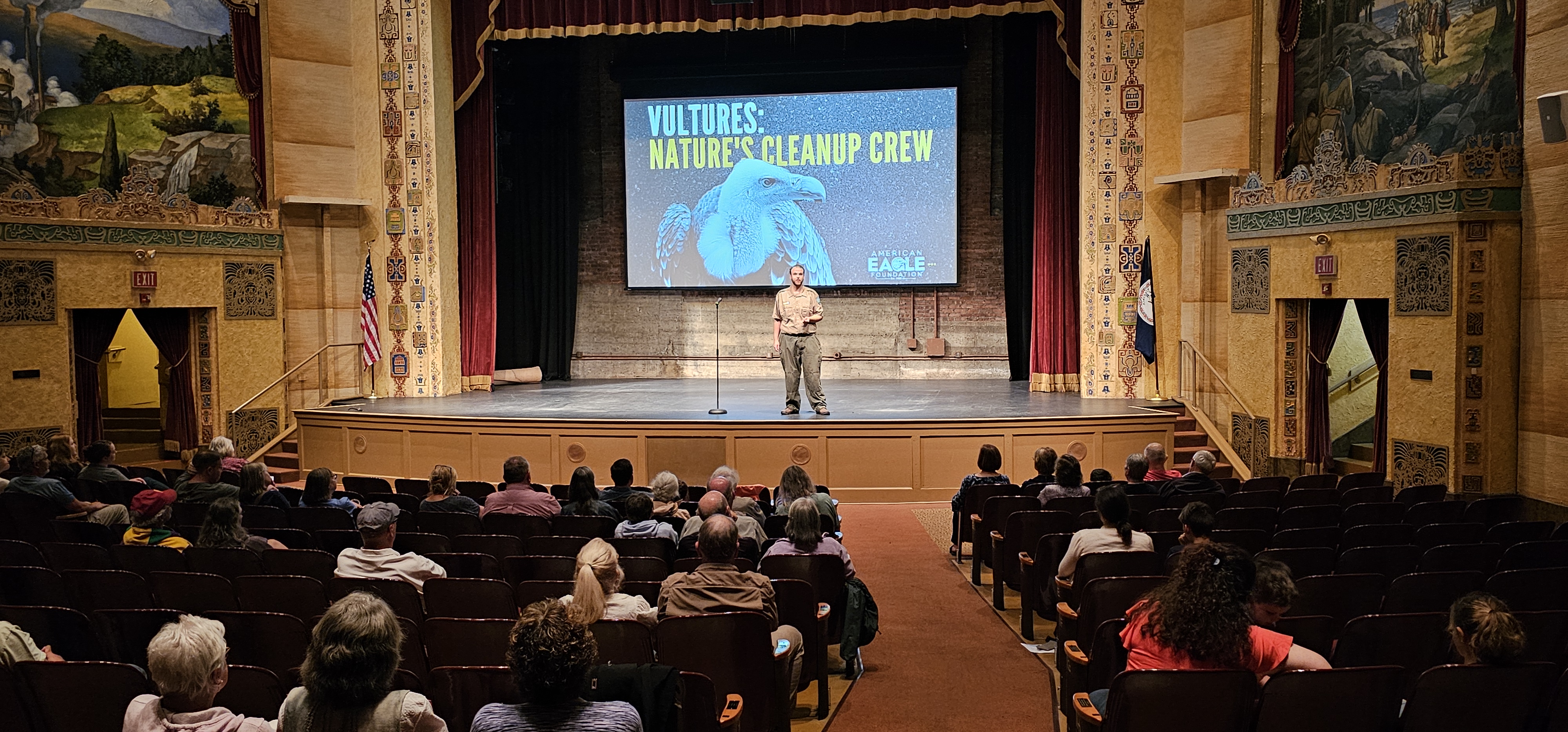
The Holston Rivers Virginia Master Naturalist Chapter partnered with Hungry Mother State Park to host the Life’s Extras Birding Celebration May 3-5, 2024. This event was held to honor a long-time Hungry Mother State Park and Holston Rivers Chapter volunteer, Randy Smith, who passed away unexpectedly in early 2023. He worked hand in hand with not only the Interpretive Department at Hungry Mother, but he was a huge asset and popular volunteer for the chapter also. He presented multitude of birding programs to the young and old alike. Not only did he volunteer to host birding programs, be he also gave programs on Virginia wildlife, native seeds and plants, he assisted with spring and fall field trips at Hungry Mother through the chapter to talk to the kids about birds, beavers, habitat, fish, and other aquatic organisms. In 2023 he was awarded the Volunteer Lifetime Achievement Award through Virginia State Parks. Randy was not only a volunteer, but he was also a friend, a mentor, and part of our chapter’s family. He is still greatly missed. When Randy passed away, his family wanted to do something to honor him. So all donations went to Hungry Mother’s Friends’ group to offer birding programs in the park and the surrounding community. VMN and Hungry Mother partnered together in his honor to offered fifteen different programs to almost 500 birders, locals, and campground guests on various birds throughout the May 3-5 weekend. We learned about birding by ear from kayaks, spotted 42 different species of birds on various bird hikes, explored the nearby Saltville Wellfields, learned about nature journaling from one of our favorite authors, Suzanne Stryk, and joined the American Eagle Foundation at the historical Lincoln Theater in Marion for a fun night with vultures. All in all, eight Holston Rivers Chapter members volunteered at least 115 hours to make this weekend a success. There is no way to cover all that went into this weekend, but all of us walked away with new friends, new stories to share, and a renewed passion in Randy’s favorite subject… birds. Randy would have been very honored and happy. Goodbye Pilgrim.
Reading your landscape through the Bull Run Mountains’ history: Wildflowers and Cultural Plants
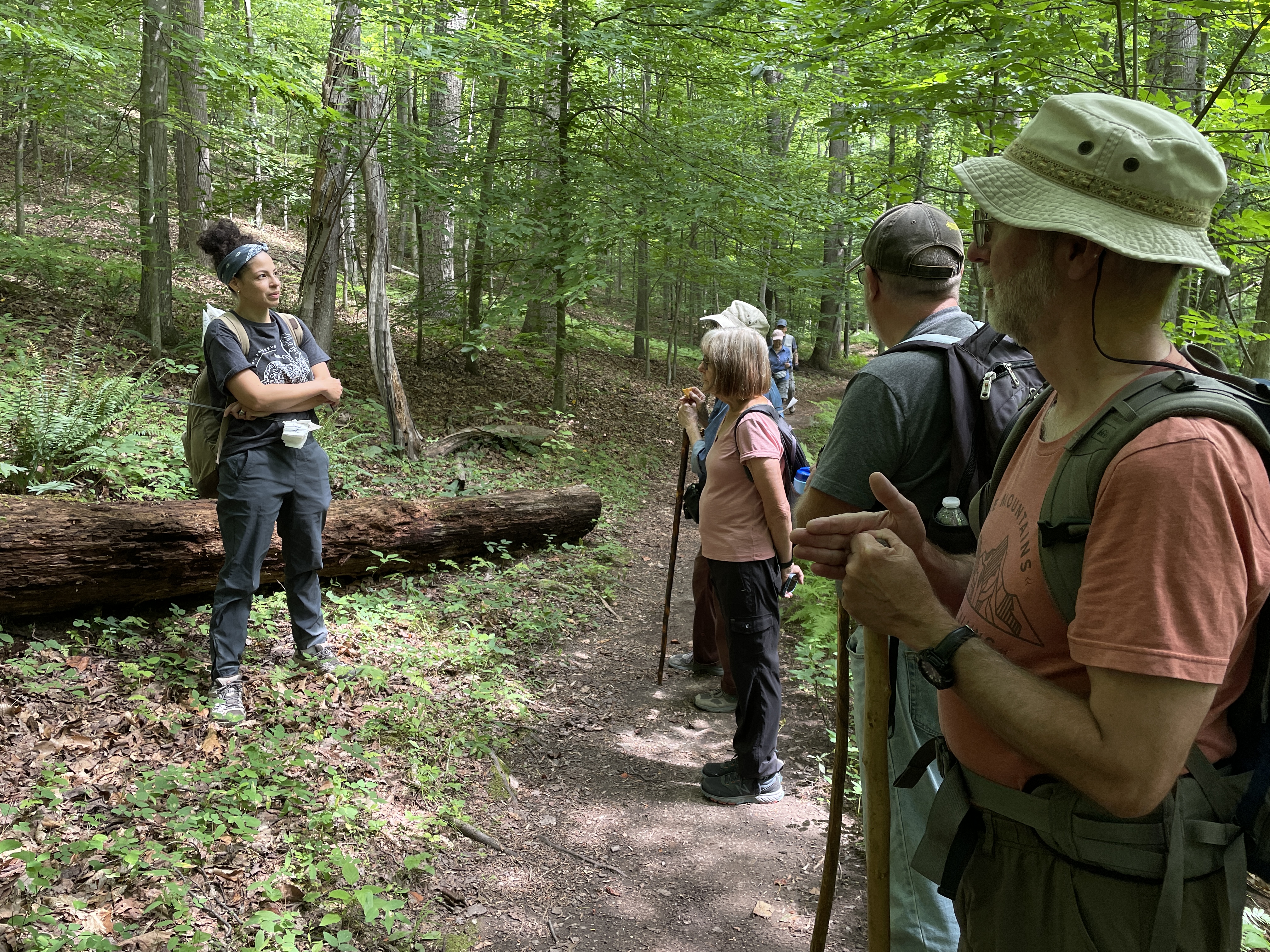
–Contributed by Penny Firth and Rikki Lucas, VMN-Central Rappahannock Chapter
Central Rappahannock Master Naturalist volunteers share here a field trip report from a unique educational experience.
On June 28, 2024, several volunteers in the chapter joined leaders Amber Miller (Black and African American History Fellow, Virginia Outdoors Foundation, Bull Run Mountains Natural Area Preserve) and Deneith Reif (Conservation Assistant, Virginia Outdoors Foundation, Bull Run Mountains Natural Area Preserve) at Bull Run Mountains Natural Area Preserve to learn about enthnobotany and the cultural history of the site.
This hike focused on native and invasive plant ID and ethnobotany through a mostly Black and African American and Native Nations historical lens. The cultural information was drawn from Amber Miller’s 2021-2023 ethnobotany study, and Dr. Susan Leopold’s ethnobotanical study of the Bull Run Mountains. Additional sources included first-hand accounts of Native Nations’ cultural uses of plants (specifically regional Algonquin, Iroquois, and Siouan Confederacies); first-hand teachings of Native Nation conservation biologists; and folkloric generational knowledge.
Highlights:
Amber Miller had flagged numerous locations where we paused to learn natural history and cultural uses of herbaceous plants, vines, understory vegetation, and overstory trees. Many of the plants were foraged for food (e.g. greens, berries, nuts, roots/rhizomes) and others had been employed historically for treating ailments. Amber was careful to mention when such uses were no longer recommended. From the anti-inflammatory bellwort; to willow oak as a numbing agent; wild yam as a supplement to the inadequate diets of enslaved people; and pale spike lobelia in the kit of midwives, Amber Miller provided memorable anecdotes for dozens of species, native and non-native.
The millennial human history of the area was brought alive as we learned about Native Nations’ trade and information exchanges with the more recent inhabitants. We learned how enslaved people quarried stone and built structures such as the old mill, the ice pit, walls, cemeteries, and houses. Many ruins of homesteads were marked by stone foundations, but also by the plants that continue to grow there (e.g. black walnut, juniper, periwinkle, lilies, and comfrey). Deneith Reif and Amber Miller explained how the history of a landscape could be inferred from the age of trees such as junipers, and the size of grapevines that sprout in open areas then hitch a ride up with saplings that grow into forest trees.
We learned of the cultural resilience of free Blacks as well as enslaved people, protecting their mojo, and caring for their loved-ones with foraged food and medicines. The cemetery we visited near the end of the hike was a poignant reminder of the junction between the past and the future of this beautiful natural area.
Central Blue Ridge Master Naturalists at the Market
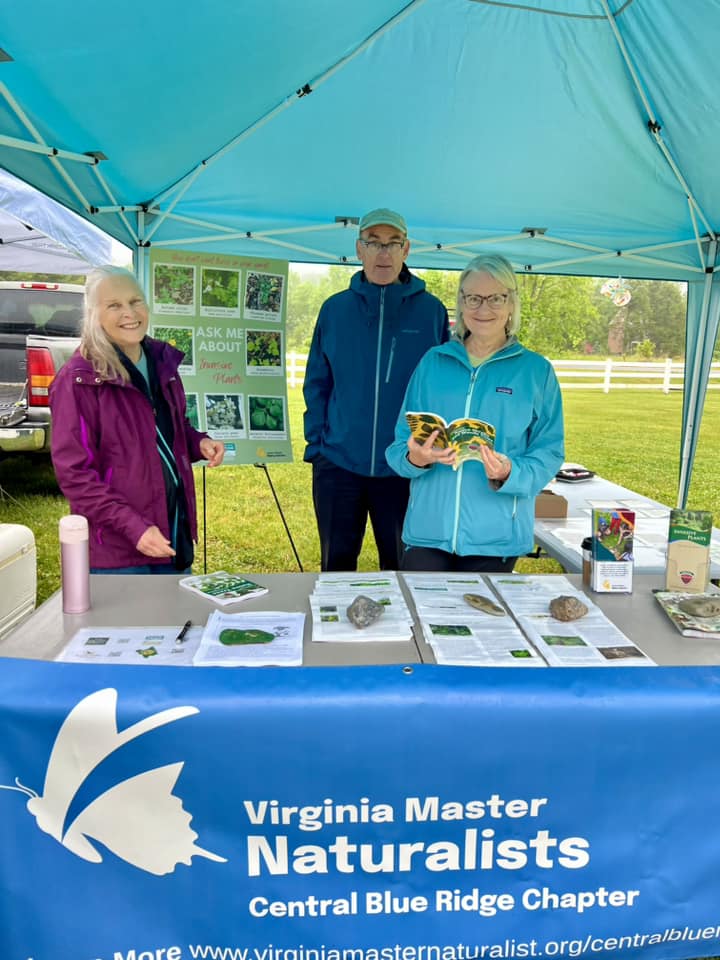
–Contributed by Lena Kroll, VMN-Central Blue Ridge Chapter
Small But Mighty! Our amazing 80-member Central Blue Ridge Master Naturalist chapter continues to make a big difference in our community. On June 8, CRB staffed an informative table at the Nelson Farmers Market Cooperative in Nellysford. The theme: Our Wildlife Neighbors.
Our community partner The Nature Foundation at Wintergreen & a private collector ensured our chapter display was a real attention grabber by providing animal pelts, a bear skull, faux bear scat, animal tracks, and a taxidermized Gray Fox!
The themes vary monthly and include Fighting Back Against Invasive Plants, Our Flighty Friends, Living with Bears, Dark Skies & Bird Migration, and Getting Your Yard Ready for Winter. Each month the chapter features a fun hands-on activity for kids of all ages too.
2024 chapter goals include raising awareness of CBR activities in the community and demonstrating the mission of the Virginia Master Naturalist program. We’ve shared our knowledge and enthusiasm with more than 200 direct contacts during the first two months of this new program! Plus, it gives our chapter a chance to team up with our many important partners.
Our chapter has committed to participating at this very popular event on the 2nd Saturday of the month through October. So, if you’re visiting the Blue Ridge Mountains this summer or fall, please stop by to say “hello.”
Junior Naturalists in Southside Virginia Visit the Tanner Environmental Education Center at John H. Kerr Dam and Reservoir
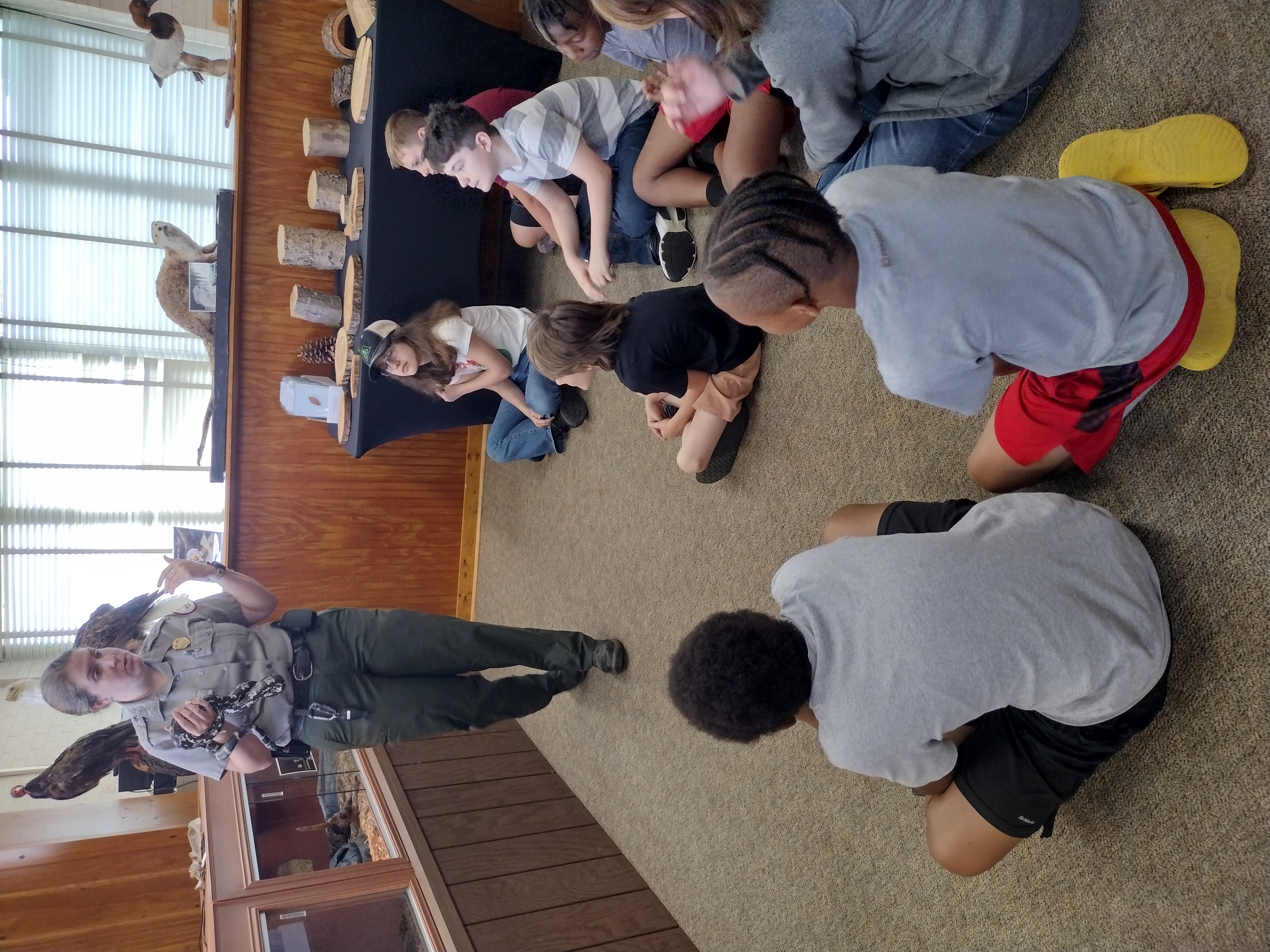
–Contributed by Scott Wright, VMN-Southern Piedmont Chapter
While walking a trail …
Master Naturalist to a Junior Naturalist: “Have you ever seen a red velvet ant?”
Junior Naturalist response: “You do know they are not really ants, don’t you?”
And the point was proven- Junior Naturalists know a lot!
On a May morning, a group of upper elementary age youth; Southern Piedmont Master Naturalist volunteers; and the 4-H Youth Development Director with Virginia Cooperative Extension, gathered at the Joseph S. J. Tanner Environmental Education Center at John H. Kerr Reservoir in Mecklenburg County. It was the beginning of a day in which students experienced the colors and variety of the pollinator garden; walked a shady woodland trail and saw the results of controlled burning in a forest; played animal identification games in the picnic shelter; watched herons, ospreys, and cormorants at the Roanoke River; viewed the massive John H. Kerr Dam while learning how it generated power and controlled flooding; and touched Elvis- the eastern king snake!
The goal for the day was for youth to experience the natural world and to remember and practice concepts accumulated through participation in the first Junior Naturalist Club in Mecklenburg County. The Club was a cooperative undertaking between the Southern Piedmont Master Naturalist Chapter and Virginia Cooperative Extension. At five monthly meetings beginning in February, the sixteen enrolled students learned about Tracks and Scat, Stream Ecology, Insects and Pollinators, Leaves and Tree Identification, and Bird Basics. Each class was taught by volunteers from the Southern Piedmont Chapter and Jennifer Bowen, local 4-H Director. Teachers balanced informational instruction with hands-on learning activities. Inquisitive students were wide-eyed when handling plastic scat replicas, beamed when constructing insect hotels, and laughed when messily painting leaf silhouettes. They eagerly shared their stories about wildlife in their backyards, unusual caterpillars they had seen, and other encounters with nature.
It’s hard to gauge who had the most fun or learned the most. One thing is definite, the youth arrived knowing a lot, learned a lot, and left enthusiastic about the natural world. No doubt, the Junior Naturalist Club was a successful cooperative endeavor and will keep Southern Piedmont Master Naturalists busy and on their toes in the years to come.
Volunteer Fair with the Old Rag Master Naturalists
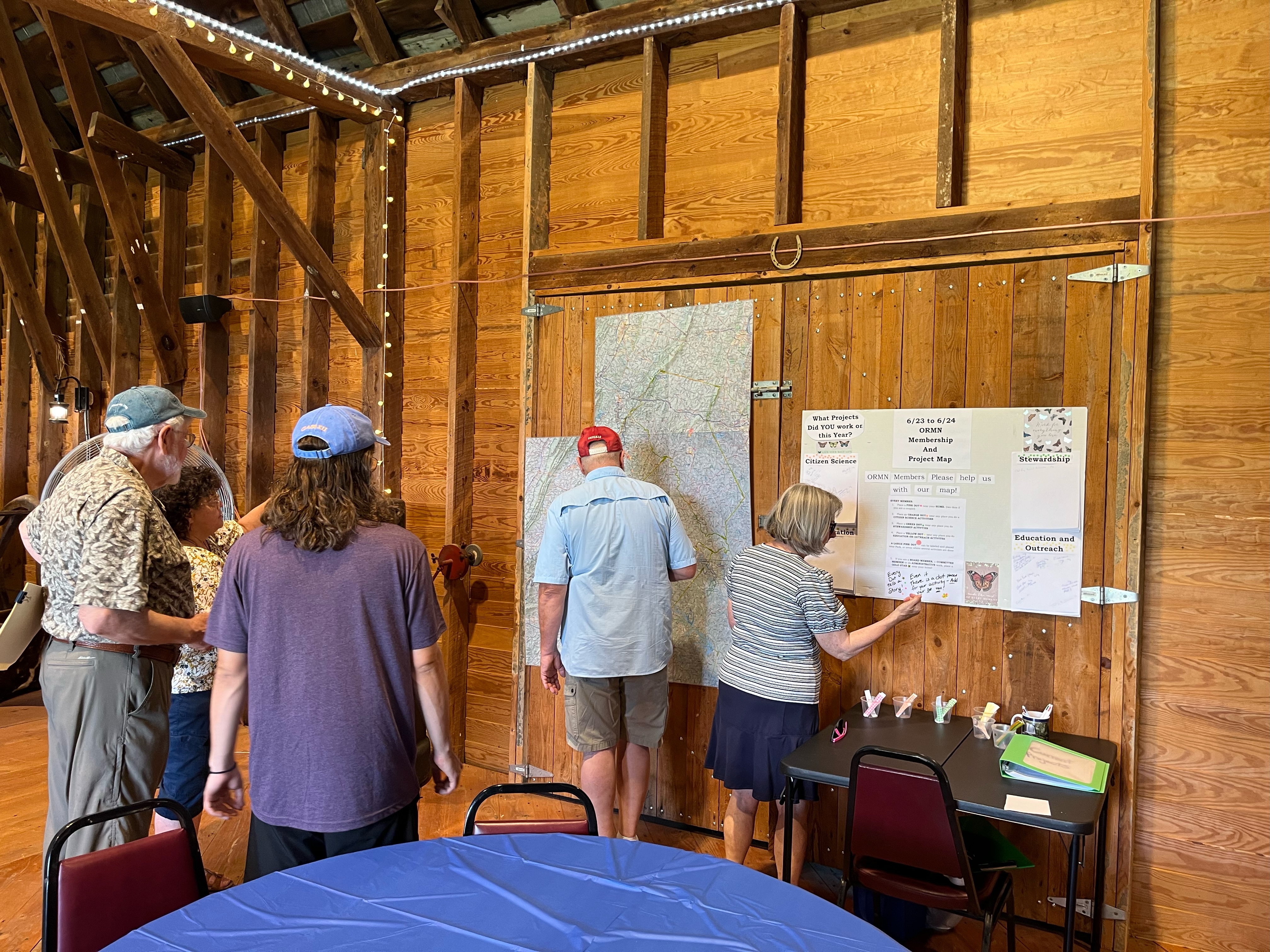
–Contributed by Charlene Uhl, VMN-Old Rag Chapter
Instead of a keynote speaker, the Old Rag Master Naturalist chapter decided to feature volunteer opportunities at our June 2024 annual meeting. Judy Edmunds and Linda Bueno, organizers of our annual meeting, recruited ORMN project leaders to host tables featuring specific volunteer projects. Nine different projects were featured, including:
- Plant Northern Piedmont Natives
- Bluebird box monitoring
- Monarch Monitoring
- Old Rag Summit Restoration
- Rappahhnoack County Park habitat restoration
- Trout in the Classroom
- Environthon
- Stream Monitoring
- Nature’s Best Mosquito Control
At the general meeting, project leaders had the opportunity to interact face-to-face with ORMN members, to describe the purpose of the project, what was involved (skills, time commitments, etc.), and the significant impact their project was making in supporting nature.
The response from our members was exceptional. Each project reported visitors to their table, one table with 25 members expressing interest. Almost every project had one or more members sign up to participate and project leaders report that some have already started participating.
“I thought the project fair was a great way to give the new graduates an idea of the scope of our service projects, as well as to let longer-term members know about activities they might not be familiar with.” Carolyn Smith, Chair
ORMN Projects Committee
In addition to the tables featuring specific projects, a large map of ORMN’s six-county catchment area was displayed. Members were invited to place colored dots to show where they lived as well as the location of the projects where they were volunteering. This turned out to be a fun exercise that showed the wide distribution of our members as well as the multiple areas where we are involved in citizen science and stewardship. This visual display help to highlight the impressive volunteer efforts our members are making across our six counties. The consensus of our members: “having project tables is effective” – and we should plan on doing this again in the future.
Peninsula Master Naturalists Serve at The Mariners’ Museum in Newport News
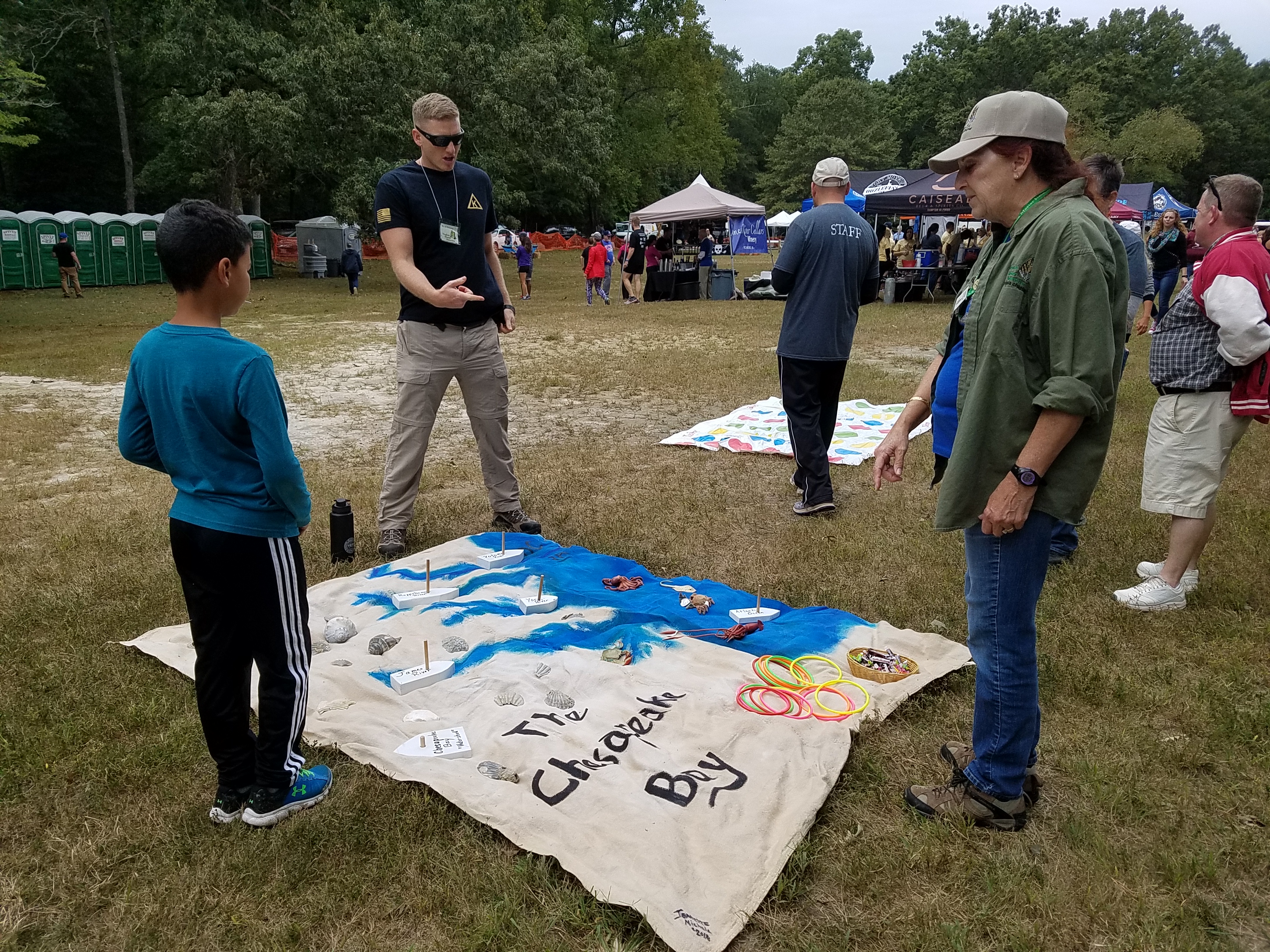
The Peninsula Master Naturalists and The Mariners’ Museum in Newport News have developed a significant and multifaceted partnership. The Mariners’ Museum is home to one of the nation’s largest privately owned parks. It surrounds the Mariners’ Lake. The park encompasses 550 acres and within it is the Noland Trail (a five-mile walking/running trail) in the center of Newport News. Access is free.
The volunteers of the Peninsula Master Naturalists contribute to the park in many ways:
- Volunteers have created and maintained two native gardens on the Noland Trail. Walkers often comment and compliment volunteers for their work in the gardens. The gardens are weeded and mulched to improve the aesthetics of the trail.
- Volunteers encouraged and initiated guided trail walks describing the flora and fauna found in the area. Museum staff and PMN volunteers have led these interpretive walks.
- Volunteers have helped museum staff with their water related educational activities. The Museum has been awarded several grants with the purpose of introducing middle and high schools’ students to water quality and the planting of water grasses. These grants have allowed hundreds of students in select grades in Newport News and Hampton to take part in water activities focused on education. PMN volunteers have gone kayaking with students, helped them plant eel grass to clean the water, and done water quality testing.
- Volunteers offer forest immersion/Shin Rin Yoku experiences monthly to the public. Forest immersion walks allow participants to relieve stress and feel healthier.
- Volunteers help with the Parks tree plantings to restore forests and help remove invasive plants such as English Ivy and stilt grass.
- Volunteers provide lake cleanups to improve the aesthetics and quality of Mariners’ Lake.
- Volunteers provide outreach activities at the Museums special events such as Military Kids day and their Fall fest.
This partnership has benefits for both the Museum and the Chapter and is one of our more active activities. The Museum website: https://www.marinersmuseum.org/park/

Laurels – Summer 2024 Read Post »
